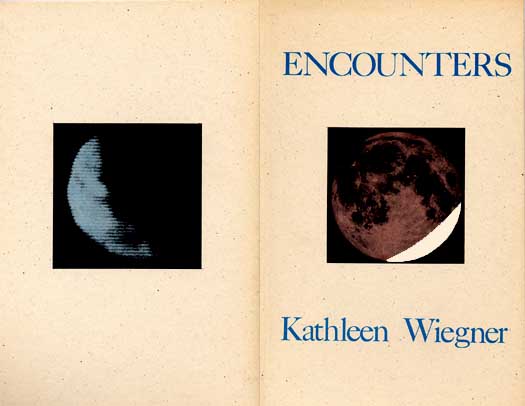In the late 1960s and early 1970s, Kathy Wiegner was one of the most dynamic
figures in the poetry scene in Milwaukee. This included organizing readings,
particularly playing a key role in setting up the massive anti-war readings
given by people living in the city and by those who put aside their
squabbles and appeared in groups of as many as seventy to read poems in
solidarity in as many cities as possible. Kathy could set up small scale
readings in the cafeteria of the student union if no other forum were
available, and her home was a place where people discussed and read their
poetry as well as engaged in the various activities considered hip.
Kathy's poems at this time tended to focus on strong imagery, but not
to make a fetish of it, as was becoming common among other poets of the
moment. Many poems included a narrative frame, but unlike the two books that
followed Encounters, story lines or situational frames primarily
reinforced the dialectics or logopoea of her poems. Irony played a strong
role in the poems, but, like imagery, never outgrew proportionate purpose.
Kathy took ideas from many sources - she was an avid reader of New York
School and Black Mountain poets, for instance - but, as with other aspects
of her work, she avoided the affectations and excesses current literary
modes encouraged in poets of the time. She could thus move through a
wide range of tropes and methodologies without ever sounding like imitation
H.D. or Muriel Rukeyser or Kenneth Koch or Denise Levertov.
Kathy's conversation could wander from raunchy counter-culture lore to
rarefied dissertations on theology. Her reading style was direct,
emphatic, and could become sarcastic. A salty quality infused her next book,
and during the year or two after the book was published, she seemed to
be creating a persona for herself. I don't think she was completely
comfortable with this, but it did provide a means of connecting with a
diverse audience, and keeping the work accessible.
The poems in Encounters were divided into two sets. The first one
emphasized astral imagery (the moon being particularly persistent) and
personal and sexual relations. In these poems people seemed to do a slow
dance around each other, at times forming conjunctions, at times moving into
more distant orbital positions. Part two moved similar patterns of encounter
and distance through less personal historical, political, and philosophical
bases. Although her later books received more acclaim (being reviewed
in such publications as Ms magazine), I like these transactional
poems better than the tableaux that attracted broader attention.
Unfortunately for me and for poetry in general, Kathy took a job with
Forbes magazine which lead her out of poetry and
into writing about business. Had this not been the case, I assume I
would have published more of her work in later years, and found ways
of "triangulating" her poetry. I did manage to get some of her image and
situation poetry into Stations magazine.
After the death of Lorine Niedecker on the last day of 1970, there may have
been two or three poets in the region writing as well as Kathy, but certainly
none better. As I was trying to set up my own publishing enterprise, and
still doing so after hours while working at Ed Wolkenheim's shop, it seemed
preposterous that not a single book of Kathy's had as yet been published.
Rectifying this situation was an early priority. Encounters was not
only Kathy's first book, it was a first in several ways for my press. It
was the first book I printed completely on the most adamantly
environmentally friendly recycled paper available. And it was a first
in a series of first books by women poets I published during
the next three decades. Feminism was in its first full flower at this
time. Male (and even many female) publishers tended to gravitate to the
rather small number of women who had already established themselves in print.
Hence a few got disproportionately large amounts of attention while others
were left no better off than they had been a decade before.
Oddly, I did most of the work on the book during a year which Kathy spent in
Mexico, foreshadowing the rest of the decade when I made initial agreements
to publish books in person with the authors, but conducted most of the
details (such as proof reading) through the mail. In this instance, the
details were transacted through the mail with a Milwaukeean.
Design of the book tended to gravitate around Ed's uneasyness about
carrying large solids with the A.B. Dick press on which we printed it,
and his perfectionist bent, which would not countenance uneven impression.
The potential for imperfection was rendered stronger by the multiple
layers of color printed on the cover. The book's solar and lunar images
thus appear in tight boxes. Initially, I was not pleased with this
limitation, but came to see it differently after the book was complete.
These tightly enclosed images suggest frustrations and the sense of being
trapped which run through the book. The fulsome squares also carried an
emblematic quality, as though they were part of a forgotten or as yet
undiscovered heraldry. Although I liked the looks of this book more as
time went on, the limitations I felt in initially producing it lead me to
try to push the limits of small printing presses beyond the bounds
they were built for.
